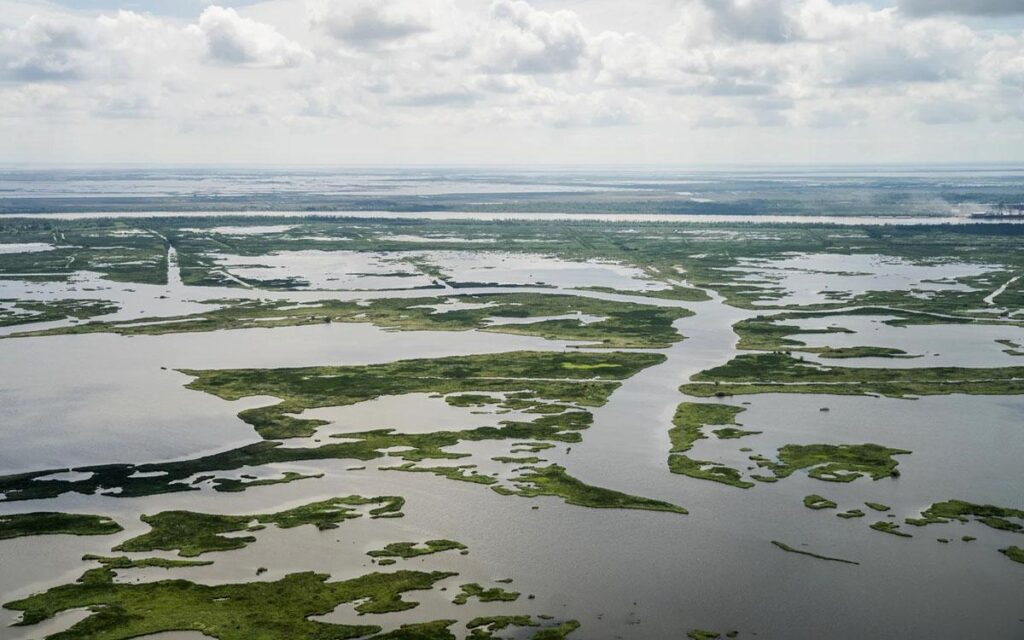A Salty River Poses Public Health Risks, Pollutes Drinking Water in Southeast Louisiana

Plaquemines Parish, located in the final 70 miles of the Mississippi River, faces increasing saltwater intrusion from the Gulf of Mexico, aggravated by climate change-induced droughts. This saltwater intrusion threatens the drinking water supply for over 20,000 residents.
An occurrence once per decade has become an annual challenge as the river’s flow drops below 300,000 cubic feet per second, allowing saltwater to advance. Last year, the saltwater wedge nearly reached New Orleans, causing widespread concern.
This year, Plaquemines Parish president Keith Hinkley noted the visible saltwater encroachment. The parish struggled with saltwater affecting drinking water in 2023, leading to bottled water purchases and damaged appliances. The chloride content posed risks of dehydration and potential lead contamination from outdated pipes.
Immediate solutions include water treatment upgrades and a saltwater sill, a temporary underwater structure preventing further saltwater ingress. Without it, the salt wedge could move 20 miles upriver, said Ehab Meselhe, a professor of River-Coastal Science at Tulane University.
Experts warn that the Mississippi River Valley needs long-term solutions beyond current temporary measures. Hydrologists like Paul Miller from Louisiana State University suggest comprehensive infrastructure changes to combat these saltwater threats.
The Atmosphere’s “Thirst for Moisture”
Saltwater intrusion in 2022 and 2023 has been partly attributed to a drought in the Midwest, affecting flow in the Mississippi River Basin. However, researchers now point to complex, multi-year weather patterns as contributing factors.
Miller examines the impact of evaporative demand, or the atmosphere’s “thirst for moisture,” on the saltwater wedge. His research indicates that periods of high evaporative demand historically align with saltwater wedge appearances.
While rainfall can mitigate low flow, extreme weather shows it is not always a solution. For instance, Hurricane Helene’s rain briefly increased river flow, but it soon returned to critical levels, explained Matthew Wilson from the National Weather Service.
Effective rain, which absorbs into groundwater, is necessary to maintain river flow, but extreme rain events often result in runoff, not replenishing groundwater reserves. As global temperatures rise, such extreme weather may become more common.
The Cost of Salt Water
Over the past three years, the saltwater sill has been Louisiana’s main defense against the salt wedge, acting as a temporary dam. Yet, it is often built too far upriver to protect Plaquemines’s drinking water. The Army Corps of Engineers spent over $20 million on sill construction in 2023 alone.
Long-term solutions remain uncertain. Meselhe is exploring ways to make river flow more efficient by addressing crevasses in levees that weaken the river’s ability to push out saltwater.
Local utilities bear responsibility for clean water, with Plaquemines Parish installing reverse osmosis systems to combat saltwater intrusion. However, the high cost—up to $1 million monthly—raises concerns about long-term affordability.
Plaquemines Parish has received state and FEMA assistance, but further upgrades may require millions more.
Greater regional collaboration could offer more sustainable solutions, similar to the Southeast Louisiana Flood Protection Authority formed post-Hurricane Katrina. Hinkley hopes for increased urgency and action when saltwater threatens southern communities.
Original Story at www.sierraclub.org
